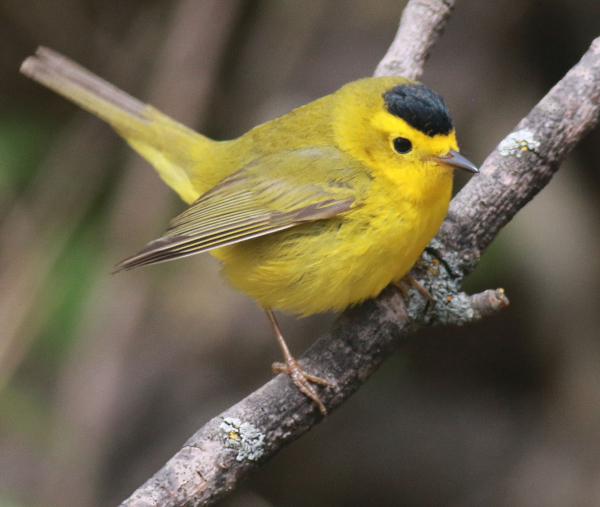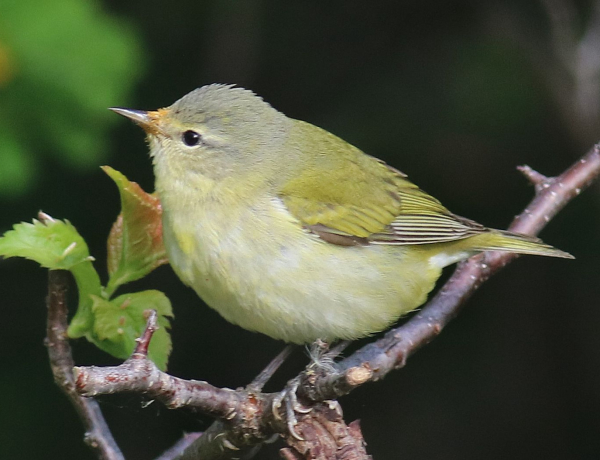
Among the many songbirds you may see in your yard soon may be a Wilson’s Warbler or Tennessee Warbler (photos by Paul Konrad).

|
In case you haven’t seen evidence of the advance of migrating songbirds yet, we can attest that warblers, vireos, thrushes, orioles, grosbeaks, and more are on their way! Is your yard, water feature, and feeding station ready for their arrival? There won’t be a local alert to let you know, but suddenly a surprise bird will fly into view, perhaps followed by another, and perhaps by a loose flock of warblers and vireos, a thrush, an oriole. It can be one bird, or a mini-wave – or it may add up to a day of migration sightings – right out your window or off your deck or balcony. It’s an exciting time for birders!
Overall, these songbirds don’t feed at typical seed feeders. They mostly feed on small insects, spiders, and caterpillars; foraging through trees and bushes, branch by branch, leaf by leaf. But they are all attracted to fresh water, whether offered in a bird bath or a trickling water feature. Orioles will certainly feed on grape jelly and maybe on sliced orange halves, and hummingbirds will definitely stop at your nectar feeder, with some other species possibly utilizing these feeders, and maybe a suet feeder. But water and major landscaping features like trees and bushes are most likely to attract fall migrants. If you have berry-producing trees or bushes, that can be a boon to attracting thrushes, waxwings, bluebirds, and some others too.
With the advance of the first migrants south from the boreal forests of Canada and Alaska into the northern tier of 48 states, it doesn’t take long for those birds to reach the central and southern tiers of states as the migrants make monumental migrations to wintering areas in more tropical climes from Mexico to Argentina. Now is when your landscaping efforts over the years and during this spring and summer really pay off for birds in need by high-energy food, along with the fresh water and varied foods you provide.
An Editor’s Example
Last week, our Editor, Paul Konrad, who lives up north in North Dakota described sightings he observed last Saturday when a varied mix of migrating songbirds arrived in his yard. He described this migration stopover event, and we share it with you here as an example of what you might experience – when you least expect it:
“From the time I awoke until dusk, Friday was filled with a surprising concentration and variety of migrating songbirds, and more – out my bay windows, in my frontyard, in my backyard – migrants were active and on the move from branch to branch along the south and west sides of my property, where the trees are – chokecherries, ash trees, a blue spruce, and sumacs primarily – what fun! First it was a colorful adult male Baltimore Oriole that I spied 70 feet away, then watched him make a beeline to my feeding station. And before he took his first taste of grape jelly, a beautiful female joined him! She waited her turn, and when the male exited, the female followed his lead at the jelly feeder.
In my backyard, I was surprised to see a male Wilson’s Warbler alight at eye level about a dozen feet away and begin foraging from leaf to leaf on the edge of the chokecherries. He came in and out of sight for about 10 minutes, as close as 8 to 15 feet at times. In the meantime, another movement caught my attention, but the bird was elusive the first half-minute, before showing it was a small male Downy Woodpecker – a rare bird through the summer, and probably a new arrival with the other migrants. Then a Swainson’s Thrush caught my eye on the other side of the thicket – can there be just one? And that was followed by a female Baltimore Oriole and another look at the Wilson’s Warbler.
Back in the house, even before sitting down at my desk, the first thing I saw was a small warbler zip by the bay windows toward the front yard. I grabbed my camera and stood at the front door to see a female Wilson’s Warbler, a male Baltimore Oriole, a couple immature Red-eyed Vireos, a Tennessee Warbler, and a young Yellow Warbler, followed by an immature female Cape May Warbler! Super! And then a double surprise; an early Red-breasted Nuthatch was joined by a second one as they worked the bark of an ash tree. Up front, the songbirds foraged the leaves and branches of the 3 mature ash trees, often within 10 feet of my doorway stand away. More of the Wilson’s, Yellow, Red-eyed, and one or more male Baltimores worked the area during the next 15 minutes – and that’s when 2 young Rose-breasted Grosbeaks perched low up front – all very exciting! This was no small migration wave, for clearly the migrants were not limited to my yard, but were moving through the trees throughout the area.
The Baltimore Orioles continued to feed on grape jelly periodically throughout the day, and the male was there a couple times in the waning light of dusk. At times, the male oriole was feeding in tandem with a Ruby-throated Hummingbird on the nearby nectar feeder. This was all more than I could have imagined, even considering there was a mini-wave here last Wednesday. That bay window wave included 2 young Red-eyed Vireos, 3 Yellow Warblers, and a super sighting – the inaugural first-fall female Cape May Warbler I’ve ever seen, and the first Cape May in my yard! The male Wilson’s Warbler was also the first Wilson’s in my yard during fall migration.”
Monitor Migrations Live
Paul’s observations are the kind we all hope for, and in hindsight, after enjoying Friday’s migrants feeding in his yard, Paul checked the BirdCast live migration map to see what the overnight migration was like (Thursday, September 2nd) across the Lower 48 States. He found there was indeed a strong migration south across the Great Plains from Canada to Kansas, which undoubtedly brought the mix of neotropical migrants to his doorstep – literally; see the BirdCast map at https://birdcast.info/migration-tools/migration-forecast-maps/
He also checked the Live Bird Migration map for September 2, which showed in graphic detail that Thursday night, after a day of rain, there was a major migration through the state of North Dakota, and many others; see https://birdcast.info/migration-tools/live-migration-maps/ and press the arrow at the bottom of the map.
What remarkable tools these BirdCast web pages are for birders! Whether at your home, on a field trip, or during other travel interests, you can check the migration potential for coming dates, or refer back to previous nights to monitor the pulses of fall migration. Just type in your location, or the date in question, and you might just be amazed at what you find – Paul was!
We backyard birders should regularly monitor on-going migration activities in our area of the Lower 48 States in advance of potential prime migration nights – what a great new information source for us all at https://birdcast.info/
Share your backyard birding experiences and photos at editorstbw2@gmail.com